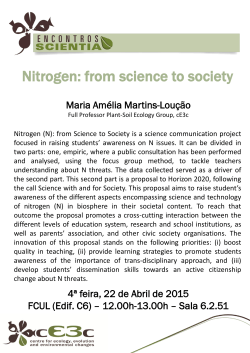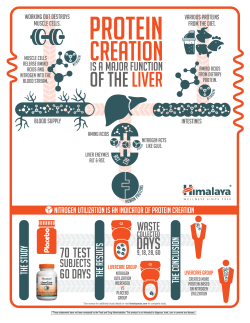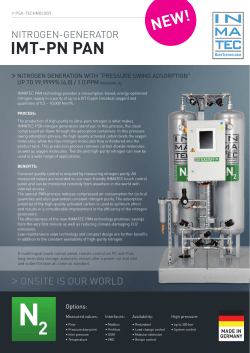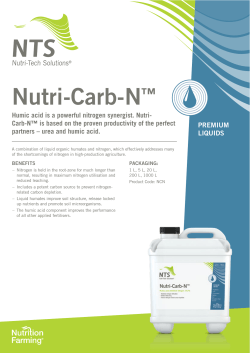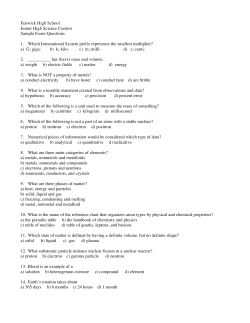
DEVNYA, BULGARIA NITROGEN (N2)
Material Safety Data Sheet Version: 02 / 02.2012 DEVNYA, BULGARIA NITROGEN (N2) CAUTION! 2.2: Non-flammable, non-toxic gas 1. PRODUCT AND SUPPLIER NAME. 1.1. Product name: NITROGEN CAS N: 7758-29-4 EINECS N: 231-838-7 1.2. Chemical formula: N2 REACH registration: not required. REACH notification: 02-2119511722-49-0000 Nitrogen is included in Annex IV/V of REACH, exempted from registration. 1.3. Product use: purging and inertization of reactors and tanks, protection and transfer of substances, sensitive to oxygen, thermoregulation and cooling of foods and chemical reactions, chemical industry, thermal treatment of metals, steel stirring, degassing of aluminum, rubber cutting, compress gas in the production of plastics, refrigeration, packaging of food products in variable environment, protection of the back of welding, hardening of steels etc. 1.4. Supplier information: AGROPOLYCHIM AD Devnya 9160, Industrial area tel.: (0519) 97 419, fax: (0519) 9 33 63 E-mail: vasileva@agropolychim.bg 1.5. Telephone number in case of emergency. (0519) 97 530 This is a 24 hour line. 2. HAZARDS IDENTIFICATION. Substance classification: Classification according to Directive 67/548/EEC: The product is not classified in accordance with this Directive Hazard identification, according to Regulation (ЕС) No 1272/2008 (CLP): Classification, according to Regulation EC 1272/2008 CLP: Pressurized Gas - Physical hazards: Pressurized gas – compressed gas – Caution (H280) Label elements: - Labeling pictograms 1 - Signal word: Hazard statements: CAUTION! Н280: Contains gas under pressure; may explode if heated. Precautionary statements: - Storage: Р410+403: Keep away from direct sunlight. Store in a well-ventilated place DANGERS! Gas under high pressure. May cause suffocation very quickly. May cause dizziness and sleepiness. An individual breathing apparatus is recommended, to save workers. INHALLATION: Small concentrations may cause headache, dizziness, agitation, salivation, vomiting. CONTACT WITH SKIN: Not hazardous. INGESTION: This product is a gas under normal temperature and pressure conditions. CONTACT WITH EYES: There is no data available on adverse effects. Not dangerous to the environment. 3. COMPOSITION. 3.1. General characteristics of ingredients and their content (%). Indicator Nitrogen content, % Humidity,% Limits 99,7 0,005 CAS number 7727-37-9 EINCS number 231-783-9 7732-18-5 231-791-2 3.2. Classification, according to the Regulation on classification, labeling and packaging of substances and mixtures. Nitrogen is not classified as a hazardous chemical compound. 4. FIRST AID MEASURES. INHALATION: Move person away from the dangerous zone into an area with clean air. Supply oxygen if breathing is problematic. Seek qualified medical assistance. CONTACT WITH SKIN: Damage not expected. INGESTION: This product is a gas under normal temperature and pressure. CONTACT WITH EYES: Damage not expected. 5. FIRE-FIGHTING MEASURES. 5.1. E x t i n g u i s h i n g media. Non-combustible gas. In case of fire in the presence of nitrogen, all available fire-fighting means can be used. 5.2. Hazardous combustion products. None. 5.3. Special hazards. Evacuate all personnel, not involved with the extinguishing of the fire. 5.4. Special safety equipment for fire-fighters. Special clothing, resistant to high temperature, gloves, boots, a breathing apparatus (Saturn, Draeger) LIMITS OF FLAMMABILITY IN AIR, %: not applicable. 6. ACCIDENTAL RELEASE MEASURES. 6.1. Personal precautions. Use personal safety equipment - special working clothing, gloves, shoes, breathing apparatus. In case of nitrogen release, immediately evacuate all personnel from the dangerous zone. If release comes only from one cylinder, take the cylinder outside and let the gas disperse. Stop the release. Ventilate area. 6.2. Environmental precautions. Try to stop release. Take measures against entrance into canals, underground areas, working rooms or other places, where building up of excess nitrogen can be dangerous. 7. HANDLING AND STORAGE. 7.1. H a n d l i n g . Use personal safety equipment – special working clothing, gloves, safety goggles or a screen. Prevent cylinder from damage. Use a suitable cart (trolley, hand truck etc.) to transport the cylinders – do not drag, roll, slide, hit. Never lift the cylinders without their valve-protection caps – the cap is made only to protect the valve. Never place objects inside the cap (e.g. wrench, screwdriver etc.) – this may damage the valve and lead to accidental release. Open the 2 valve slowly, to avoid pressure force. If valve is hard to open – stop work and contact your supplier. 7.2. S t o r a g e . Nitrogen (gas) is stored in steel cylinders and gasholder. Keep away from ignition and heat sources – heating of the cylinder increases gas pressure. Store in temperatures lower than 520С. The storage room should be dry and well ventilated, or with natural ventilation. Full and empty containers should be stored separately. Keep containers from falling and impact. OTHER DANGERS DURING WORK, STORAGE, USE: Gas under high pressure: The gas may cause excessive salivation in case of insufficient oxygen supply. Close the valve after every use; keep the valve closed, even if container is empty. Avoid the return of flow to the cylinder. This may cause cracking of the cylinder. When you return the cylinders to your supplier, make sure the valves are closed. In case of release, close the valve of the cylinder. 8. EXPOSURE CONTROLS/PERSONAL PROTECTION. 8.1. Exposure limits. Nitrogen is not classified as a dangerous chemical compound. There is no data on exposure limits. 8.2. Exposure control. Keep away from ignition sources, heat, as heating of the bottle causes an increase in pressure and may lead to an explosion. Provide reliable ventilation in the storage room. 8.2.1. Control in case of occupational exposure. Provide natural and/or artificial ventilation to prevent suffocation with nitrogen upon inhalation. Provide personal protective equipment – special working clothing and shoes, gloves, breathing apparatus (Saturn, Draeger) Airway protection. Provision of natural and/or artificial ventilation and a breathing apparatus (Saturn, Draeger). Hand protection. Wearing gloves during work is recommended. Eye protection. Wearing safety goggles during work is recommended. Protection of skin and body. Wear working shoes from natural leather with a metal toe and plate. Wear protective clothing as necessary. 8.2.2. Control of environmental exposure. Do not discharge into confined spaces, particularly on lower (ground) floors. 9. PHYSICAL AND CHEMICAL PROPERTIES. Chemical series: Period, Block Appearance Nonmetal Group, 5А, 2, р Colorless gas Atomic properties Atomic weight Atomic radius (calc) Covalent radius Van der Waals radius E configuration e- energy level Oxidation state (oxides) Crystal structure 14,0067 u 65 (56)pm 75 pm 155 pm 1s22s22p3 2,5 +3,5,2,0,-3 Hexagonal Physical properties State Density Gas 1,2506 kg/m3 3 63,14 К (-210 оС) 77,35 К (-195,8 оС) 13,54х10-3 m3/mol 0,3604 kJ/mol 2,7928 kJ/mol NA Pa at NA K 334,5 m/s at 20К Melting temperature Boiling temperature Molar volume Specific heat of fusion Specific heat of vaporization Vapor pressure Speed of sound Others Electro negativity Specific heat capacity Specific conductance Heat conductivity Ionization potential 3,04 (Pauling scale) 1040 J/(kg.K) NA S/m 0,02598 W/(m.K) 1402,3 kJ/mol 4 AGROPOLYCHIM AD Devnya NITROGEN Material Safety Data Sheet Version: 02 /.01.2011 (N2) Chemical properties Nitrogen is an extremely inert nonmetal, due to the strong covalent bond between its molecules. It reacts with: 1. Oxygen – direct formation of NO, N2O, NO2, N2O3, N2O5. 2. Hydrogen – forming ammonia (NH3). 3. Metals – at high temperatures – salt (nitride) formation. Nitrogen has a very low solubility in water. 10. STABILITY AND REACTIVITY. 10.1. Stability. The product is stable when storage conditions are met. 10.2. Conditions to avoid. Proximity to heat and fire sources. 10.3. Materials to avoid (incompatibility). In specific conditions, nitrogen may react with lithium, titanium (above 8000С) and magnesium, forming nitrides. At high temperatures it also reacts with oxygen and hydrogen. 10.4. Dangerous decay products. None. 11. TOXICOLOGIC INFORMATION. Toxicological effects of this product have not been observed. 12. ECOLOGICAL INFORMATION. 12.1. Ecotoxicity. Nitrogen is not toxic and does not pollute soils and waters. 12.2. Mobility. See. 12.1. 12.3.Bioaccumulation. The product does not have bioaccumulative properties. 13. DISPOSAL CONSIDERATIONS. Do not try to vent the remnant or unused nitrogen from the cylinder. Return cylinder to supplier. 14. TRANSPORT INFORMATION. Nitrogen is transported in steel bottles under pressure. The bottles must be well secured (in pallets) and with safety caps. UN №: 1066 Labeling ADR: - - 2.2: Non-flammable, non-toxic gas ADR/RID H.I. nr: 20 Name During transport: NITROGEN, COMPRESSED ADR class: 2 ADR/RID code for classification: 1А Guidelines for packaging: Р200 Additional transport information: avoid transporting with a vehicle, in which the load is not separated from the driver’s seat. . 5 Before shipping this product: Make sure that containers are secured; Make sure, that cylinder valves are closed and do not let nitrogen out. Make sure, that the valve-protection mechanism is intact. Make sure there is sufficient ventilation; Comply with applicable rules. 15. REGULATORY INFORMATION. This Material Safety Data Sheet has been prepared in relation to the requirements, set out in the REACH Regulation, Regulation ЕС 1272/2008 (CLP), standards and legislation in the field of healthcare, safety and environment. 16. ADDITIONAL INFORMATION. Standard texts, warning about the risk, related to the use of the hazardous chemical compound (R-phrases). None Standard texts, providing advice on the safe storage and handling of the hazardous chemical compound (S-phrases). S9: Keep container in a well-ventilated place S23:Do not inhale vapors. Symbol: None AGROPOLYCHIM AD kindly asks everyone, who is using nitrogen, to carefully read this information material on safety and to be informed about the dangers from this product and the safety information. This document is only a guideline for the correct and safe handling of the product by employees and clients with suitable education. Persons, receiving this information must make an independent assessment, regarding its applicability to the specific objectives.. I, the undersigned Savina Ognianova Stoitsova, personal ID No. 8412246793, certify hereby that this is a full, true and correct translation from Bulgarian into English language of the attached document. The translation consists of 6 (six) pages. Translator: Savina Ognianova Stoitsova 6
© Copyright 2025
